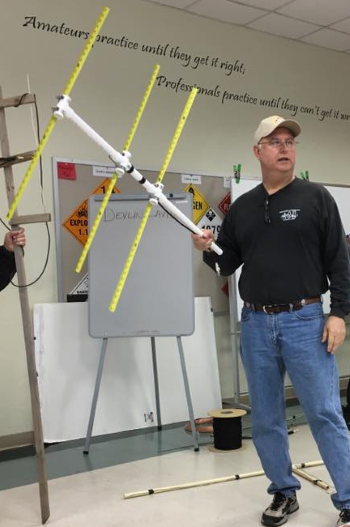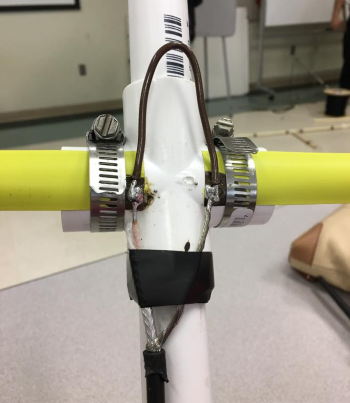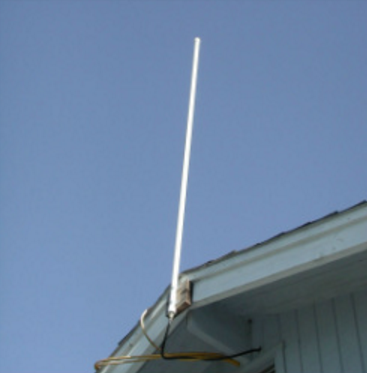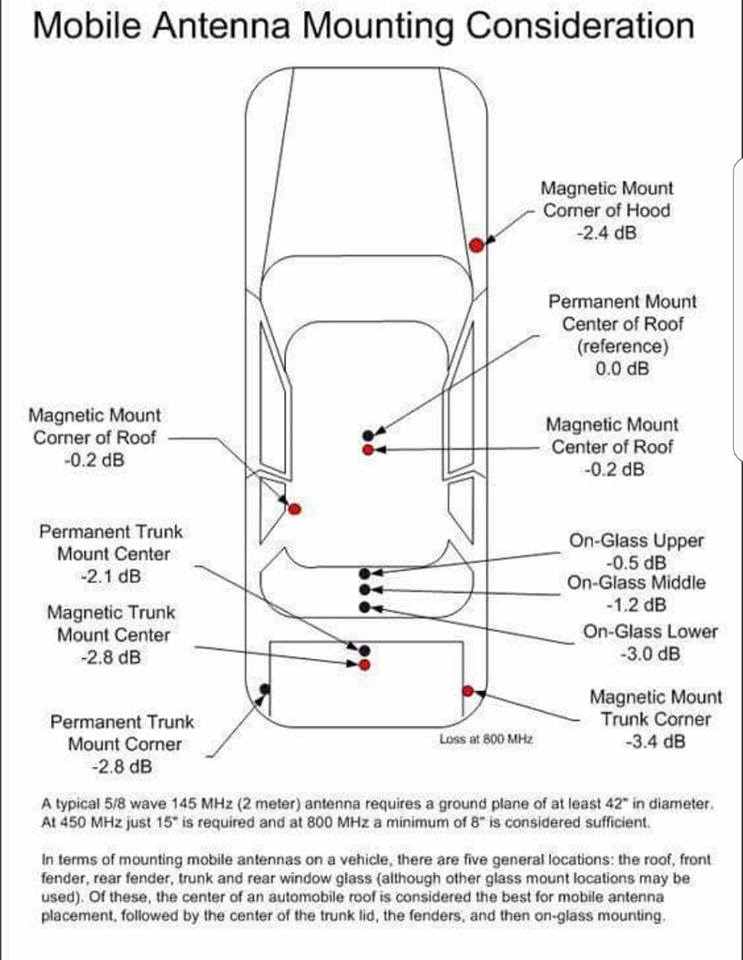This page lists a number of resources for all of us that dream, design, and build the last piece of gear that our signals touch, as they race out of the shack.
Your First Antenna
This article from the Radio Society of Great Britain (RSGB) talks about building your first HF antenna. This page goes through the theory, design, and construction of a 1/2 wave dipole.
Two Meter Vertical Loop Antenna
Andrew VK1AD has a great example of building a two-meter vertical loop. His version is meant to be a portable antenna that easily slips on the top of a vertical rod. However, this antenna would also work great in a permanent installation.
W2BLC Antenna Links
SCARS Gary Skaggs WB5ULK says “I cannot say enough about this website! There are truly DOZENS of build it yourself antenna projects on this site. But for those of you who cannot or do not want to build your own antenna, there is an extensive listing of antenna manufacturers listed at the bottom of the page. You can also learn a lot more about ‘why’ an antenna is built that way it is, how much, if any, gain you can expect, and with a little research, you should have a really good antenna to meet your own needs for not a lot of money – if you build it yourself. And I’m a great believer in build-it-yourself-if-you-can antennas!”
Stealth Vertical Antenna
This has to be the original Flagpole Vertical Antenna. This antenna disguises a vertical inside the pole. This is from 1965, and what’s old is new again!
Yagi Antenna For Space Reception
Diana Eng has a great article on Make Magazine that talks about building handheld Yagi antennas that can be used to listen, and talk, to the orbiting space satellites, including the International Space Station. Take a look here, to see how to build your own VHF / UHF antenna setup.
Another $4 Yagi Antenna For Space Reception
Are you looking for an inexpensive VHF/UHF antenna for space operations, or direction-finding? Zed Zed has a great VHF / UHF antenna setup that you can build for cheap.
VHF or UHF – PVC Using 3D Printer
So, you have access to a 3D printer and you’re looking for something to build? How about building a VHF or UHF beam with a stick of 1″ PVC and a few 3D printed parts. Here on Thingiverse is one that you can build for cheap.
Cheap and simple VHF/UHF Yagis
The three previous entries show you four different ways to build a VHF or UHF directional yagi antenna. Once you figure out a construction method, here’s a great resource to determine the wire length and spacings of an antenna. DK7ZB has a great VHF / UHF antenna design page on QSL.net that you can use to calculate the details. It’s not very clear, but if you click on the items in the yellow bar at the top of the page, you can select the number of elements and band that you want to build. On these pages, you’ll see an expected SWR chart, a picture of the assembly, detailed lengths and spacings, and expected gain and pattern charts. Additionally, you’ll see information on how to stack a pair (or more) of these to increase the gain/pattern effect.
J Antenna Audio Discussion – Denny WA6DKD
Our own Denny WA6DKD is one of our local Antenna Elmers, and he always does a great job on helping us with different antennas. On January 1, 2017, Denny, and DJ walked through the setup of a J Antenna on the 147.06 MHz repeater. This 53 minute discussion walks through design, implementation, theory, and construction of one of our favorite antennas.
Audio Player
G7FEK Limited Space Antenna
We have no personal knowledge of this antenna, but it appears to be a great 80/40/30/17/15/12 and maybe 20/10 in only 46′ of space. This antenna looks interesting, and we’d love to see it built. If you make this work, let us know at [email protected].
VHF Tape Measure Yagi
This information is from an ARRL antenna document, which says… The tape measure antenna is a simple, hand-held 2 meter Yagi; that is fun, inexpensive, easy to build. The tape measure antenna is a “homebrew” 2-meter antenna made out of PVC pipe and a steel tape measure.
This antenna is useful (especially if you want a portable antenna for backpacking etc.) for any radio or satellite use that uses 2-meter frequencies. Here’s a great example, thanks to the photography of Michelle Carey W5MQC, and the modeling by Victor McDaniel K5VL:


These tape measure antennas are similar to the ones shown at local SCARS meetings and can be built for about $10. Take a look at the SCARS version at this link.
Bent Dipole Simulations
Let’s say you want to put up a dipole antenna, but your property, trees, or other obstructions mean you have to bend the perfect dipole to fit your area. Dick Reid KK4OBI has a great website that lets you visualize how your antenna will transmit given a ton of variables, like frequency length, height above ground, and bends in the wires. Here you might get some ideas why your favorite antenna works, and why others don’t work so well.
Non-Resonant Wire Lengths
Are you working with an end-fed halfwave antenna? Or, do you have a need for a non-resonant length of wire or coax? Take a look at the University of Delaware’s random wire length web page. On this page, you will be able to find random lengths of wire that are not resonant on given bands.
London, Ontario, Temporary Car Mount
“I stumbled across the SCARS website and noticed the Bike MS page. I also volunteer for communications with the local MS Bike ride. One thing that caught my attention was the fact that you may need to duct tape onto the vehicles. Our primary support vehicle that we provide communications with are handicap accessible buses. The only area to set a magnetic mount antenna is in the area of the hood as the rest of the body is fiberglass. This provided poor results accessing the repeaters along the route, so a number of London, Ontario hams came up with another idea. This was a collaboration between John Pederson VE3MGR, Mike Watts VE3ACW, Jim Morris VA3AHQ and original testing by Norm Campbell VA3XCN. Norm actually went to the Voyageur bus yard and tested the suction cups on a bus to see if it would work. I thought I would share with you what we have used for the last couple of years.”
“Components are simple. A 3 suction cup dent puller, a length of 3/4″ inch ABS pipe (I used 4 feet), couple worm gear hose clamps, and a ground plane kit for a mobile whip.”

“Unfortunately I don’t have a picture with the antenna mounted on the ABS. Since this is used on buses, we mounted the suction cups on a window. This mount works quite well for us. Tested on the side of a Ford Explorer travelling at 70 mph with a Diamond SG-7500NMO mounted on it. Also, it supported the weight of a 200 lb man when it was attached to a side window of a bus.”

“This may be an option that you could use in the future.
73
John Visser, VA3MSV
London, Ontario”
This is brilliant, just had to use John’s words, and we’ll be trying some of these next year! Here’s some sources of the suction cups… Northern Tool: $10, Walmart Online: $13.50,From China: $28, From China: $38, Harbor Freight: $8, Grainger: $13, Home Depot Online: $20 – Thanks N5HZR
Almost 300 Wire Antennas for Amateur Radio
Iulian Rosu YO3DAC has a great collection of Amateur Radio goodies on his site at QSL.net, but this page gives almost 300 different wire antennas for you to review, covet, and build.
G5RV Information
The G5RV antenna has been around for generations, and it is a non-resonant antenna that requires a tuner. This link talks about how to build one, and use it. They also talk about the theory behind this piece of wire that performs on 5 bands.
Ed’s Antennas

This antenna showed up on the SCARS Facebook page from Chuck Crawford, and it interested me. Ed’s Antennas have exterior vertical antennas for dual VHF/UHF and the 220 ham bands. These antennas are about $30. What’s interesting is that Ed Fong WB6IQN is a university professor and has sold 16,000 of these antennas over the past ten years, and the profits go to help his student group. He’s even got a +5dB patented gain UHF antenna for $40. All kinds of crazy cable, cable length and connector options. You pay the actual shipping from Santa Monica, CA. Jump on our Facebook Group and ask how it works, there are a couple of these in town!
Non-Resonant Wire Lengths
To get your antenna system operating smoothly, you may need to make sure that your feedline, or other antenna parts are non-resonant on the most of amateur bands. There’s a great page from the University of Delaware that shows a number of options.
Using RG-6 for Amateur Radio Feedline
In rebuilding his radio shack, Mark Kleine N5HZR started using quad shield RG-6 coaxial cable for his amateur radio antennas and is reporting good results.

The pros of using this cable are that it is relatively cheap, (about $.07 per foot), and available everywhere, even at Home Depot. It is also UV resistant, and it’s cheap, ($40 for a crimper, toner, and connectors), and easy to crimp F connectors as you need them. There’s even F female to PL-259 adapters available for a couple of bucks each to let you connect directly to your radio or antenna. You can get F female to BNC male adapters if you need those connections. A toolkit is about $33, and you can even directly crimp BNC jacks to the quad shield RG-6.
Cable companies use an RG-6 cable with frequencies up to 3 GHz. The cable also has low loss numbers in the ham bands. For example, this chart shows that at 10 MHz, RG-6 loss is .6 dB / 100, RG-58 is 1.4 dB / 100, and RG-8X loss is 1.0 dB / 100. We recently used a 250-foot segment of RG-6 at Field Day, and the system performed without any issues. Loss figures at 10 MHz would be 1.5 dB, slightly lower than the 2.5 dB of RG-8X, or 4.5 dB of RG-58.
The cons of using RG-6 is that the characteristic impedance of this cable is 75 Ohms, and hams typically use a cable that has a characteristic impedance of 50 Ohms. Most radio gear transmitter ports state that they have a 50 Ohm output. Since all antenna work is a compromise, this difference may be more academic than problematic. For example, a 1/2 wave dipole, mounted 1/2 wave above ground presents a 72 Ohm load. So, even using 50 Ohm cable presents issues with impedance mismatch. Belden, a major cable manufacturer, has a page that talks of why 50 Ohm cable was selected.
So, like everything else with amateur radio, it matters less what you use, it matters more that you DO something.
Coaxial Transmitting Chokes
The practice of installing chokes on antenna feedline is about 1 part science, and 8 parts religion. Here’s a great powerpoint by Jim Brown K9YC, that talks about all of the different methods to connect a radio to an antenna, and how to make that connection work efficiently. Um, yes, this is 168 pages of fun!
Horizontal Loop Antenna Construction
Horizontal loop antennas are a great way to start building your wire antenna farm. The idea of these antennas is that you build a wire loop that connects your coax tip, with the coax shield and hang that wire in the air. This works best when you capture the largest area inside the loop. By the math, this means a circle, but those get hard to hang. Typically you’ll find square and triangular (delta) loop antennas are the easiest to hang. Other irregular forms are very acceptable. Randy Davis K5RCD, from the San Antonio, TX area has a great web page that explains how to design, build, and operate this type of antenna.
Skywire Loop Antenna
Some call it a Skywire Loop Antenna, some call it a W0MHS Loop Skywire Antenna, nowadays it’s called a Full Wave Loop Antenna but it still is a powerful antenna. 574′ of wire for a 160 M full wave antenna that tunes 160 M through 10 M. With a remote tuner attached at the feed point, this antenna tunes it all. Jason Buchanan has a great page that explains his efforts in building one of these antennas.
Resonant Wire Antenna Efficiency
SCARS Kenn Goodson KA5KXW found a white paper by David J. Jeffries that was published in the antennaX journal in Issue No. 119 – March 2007. This PDF version talks about the different materials that can be used to build amateur radio antennas. Here he compares these different materials: silver, copper, steel, gold, aluminum, brass, tin, lead, stainless steel, tin-lead solder, and zinc. The Jeffries article shows the power loss per 100 watts in each of the different materials. The results are fairly obvious, BUT what you’ll find is that there are only a couple watts, per 100, difference between the best copper, and the steel/aluminum wire that you may be tempted to use. So, like the rest of amateur radio, use what you’ve got.
Home Made PVC Antenna Tee
We are always looking for a new way to connect the center of a dipole to the coax. This PVC method looks easy and we will make this one for the next dipole.
PVC/Copper Pipe 2 M Vertical Dipole
Jim Feldman W6JMF builds an odd 2 meter vertical dipole, that can be portable or mount permanently on a vertical surface. Everything you need to build this antenna can be found on this page.
Moxon 6 Meter 2 Element Beam Plans
Michael Martens KB5VBR has a number of great antennas, and plans. His version of the Moxon dual-element 6-meter beam looks great. Easy to build out of wire and PVC, you can mount this permanently, or use it as a temporary antenna for mobile events. This beam should get you 6 dBi of forward gain, and about a 25 dB front to back ratio. Click here for a link to his site.
Vehicle Antenna Placement Chart
Build a NOAA Weather Radio Antenna
The National Weather Service (NWS) has a great article on building an external antenna for your weather radio. A number of these radios have an RCA jack that can be used for this purpose. An RCA jack to F connector will make the connection easy. These connectors are available from the Norman Emergency Manager, David Grizzle, or through various Internet sources.

